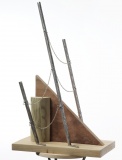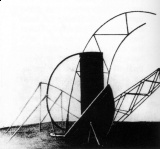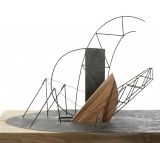Mieczysław Szczuka
 Autoportret z paletą [Self-Portrait], 1920. Oil on canvas. 134,5 x 91 cm. MN Warsaw. | |
| Born |
October 19, 1898 Warsaw, Poland |
|---|---|
| Died |
August 13, 1927 (aged 28) Tatra Mountains, Poland |
| Web | Culture.pl, Artyzm, Wikipedia |
| Collections | MS Łódź 7 +, MN Warsaw 1, Pompidou |
Mieczysław Szczuka was a Polish constructivist and productivist artist, and mountaineer.
Contents
Life and work[edit]
Born 1898 in Warsaw. 1915-18 studies painting at the Academy of Fine Arts in Warsaw under Miłosz Kotarbiński, where he meets his future partner Teresa Żarnowerówna. Makes paintings, graphic art, sculptures, photomontages, abstract films, book illustrations, theatre sets, magazines and posters. 1920 exhibits expressionist paintings with religious motifs at the Warsaw's Polski Klub Artystyczny. Abandons easel painting in favor of "formes mobiles" and design. 1921 joint exhibition with Henryk Stażewski and Edmund Miller at the Polski Klub Artystyczny, presents a multi-faceted spatial compositions made of wood and papier-mâché as a result of experiments on the effects of textural and color intensity. May 1923 exhibits spatial design, typography and theatre works at The New Art Exhibition in Vilnius (Konstrukcja przestrzenna - Portret rewolucjonisty, 1922). 1923 exhibits monuments and abstract films in Der Sturm gallery in Berlin with Żarnowerówna. Collection of his early expressionist and religious works exhibited in the Warsaw's Towarzystwie Zachęty Sztuk Pięknych under the pseudonym Józef Rekuć. Diagnosed with tuberculosis, 1923 moves to the mountain resort of Zakopane at the foot of Tatras, starts mountaineering, 1923-27 repeats some most difficult climbs of the time and establishes his own new routes. 1924 co-founds the Blok group, publishes its programmatic texts in its journal which he co-edits. Participates in the Blok inaugural exhibition at the Automobile Salon of the Laurin & Clement company in Warsaw. November 1924 exhibits with Żarnowerówna at the International Art Exhibition organised by Contimporanul group in Bucharest. 1924 joins the Polish Communist Party and begins to work with the Nowa Kultura [New Culture] journal, for which he designs the constructivist typographic layouts. His most famous book cover designs include Ziemia na lewo by Bruno Jasieński and Anatola Stern (1924), and Dymy nad miastem by Władysław Broniewski (1927). Defends Constructivist utilitarianist ideas in polemics with Antoni Słonimski. With Żarnowerówna they oppose Strzemiński's experimental assumptions with the productivist doctrine, calling for instrumental function of art. In search of new forms he turns to industrial and interior design. Since 1925 primarily architecture design; 1926 co-initiates and participates at the International Exhibition of Modern Architecture in Warsaw; 1927 takes part in the Exhibition of Modern Architecture in Moscow. 1927 starts the Dźwignia journal affiliated to the Communist Party as its editor and publisher, promotes productivism; first issue in March, four issues are produced before his death; the editorial of the first issue states: "Zadaniem 'Dźwigni' jest skupienie tych pracowników kultury (literatów, plastyków itd.), którzy stoją na gruncie dążeń współczesnego proletariatu. [..] Najlepsza kontrolą celowości i skuteczności naszej pracy będzie ściśle trzymanie się bazy marksistowskiej." Dies 1927 in an accident while climbing the south face of Zamarła Turnia in the Tatra Mountains with two novice climbers.
Works[edit]
Spatial Construction—Portrait of a Revolutionary [Konstrukcja przestrzenna—portret rewolucjonisty], 1922. Metal, wood. Łódź (reconstruction 1983).
Spatial Construction—Portrait of a Revolutionary, 1922. Reconstruction by Yan Tomaszewski, 2013. Photo: Aurélien Mole. [1].
Spatial Construction [Konstrukcja przestrzenna], 1922. Reconstruction by Yan Tomaszewski, 2013. Photo: Aurélien Mole. [2]
Project for a Monument to Freedom, 1922-1923. Reconstruction by Yan Tomaszewski, 2013. Photo: Aurélien Mole.
Literature[edit]
- Anatol Stern, Mieczysław Berman (eds.), Mieczysław Szczuka, Warsaw: Wydawnictwa artystyczne i filmowe, 1965, 192 pp. (Polish)
- Stanisław Czekalski, "Międzynarodówka Salonów Automobilowych i hagiografia rewolucji. Mieczysław Szczuka na r ozdrożach nowej sztuki", Artium Quaestiones 9 (1998), pp 75-109. (Polish)
- "The Internationale of Automobile Salons and the Hagiography of Revolution. Mieczysław Szczuka at the Crossroads of New Art", trans. Alicja Weikop, Art In Translation 4:2 (Jun 2012), pp 211-244. (English)
- Irena Kossowska, "Mieczysław Szczuka", Culture.pl, July 2002. (Polish)
- Zofia Radwańska-Paryska, "Witold Henryk Paryski", in Wielka Encyklopedia Tatrzańska Wydawnictwo Górskie, 1995; 2004. [3] (Polish)





